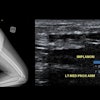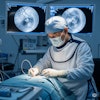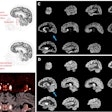
NEW YORK (Reuters Health), Jun 9 - Multislice computed tomography (MSCT) can accurately identify significant coronary artery disease prior to aortic valve replacement surgery, according to a report in the May 16th Journal of the American College of Cardiology.
MSCT offers promise as a noninvasive technique for detecting obstructive coronary artery disease, the authors explain, but it has not been studied extensively for the preoperative evaluation of patients with valvular heart disease.
Dr. Martine Gilard and colleagues from Brest University Hospital, France, investigated MSCT as an alternative to coronary angiography for the preoperative assessment of 55 patients with severe aortic valve stenosis.
Lumen assessment by MSCT was prevented in at least one vessel of 14 patients (25%) by heavy calcification, motion artifact, and/or low signal-to-noise ratio, the authors report. Five of these 14 patients had coronary artery disease on conventional coronary angiography.
Six patients had evidence on MSCT of coronary artery disease, and all six had coronary artery disease by coronary angiography.
None of the 35 patients with normal MSCT showed significant coronary artery disease on conventional coronary angiography, the results indicate.
The sensitivity of an abnormal or inconclusive MSCT for detecting coronary angiography-confirmed coronary artery disease was 100%, the researchers note, and the specificity was 80%. On the same basis, MSCT had a positive predictive value of 55% and a negative predictive value of 100%.
A calcium score of 1000 provided the best value for minimizing the number of noninterpretable MSCTs and the highest proportion of patients in whom MSCT alone could rule out coronary artery disease, the report indicates.
"The results of this initial experience in relatively few patients suggest that multidetector CT-based coronary angiography may serve as an alternative to invasive coronary angiography to rule out significant coronary artery disease in patients scheduled for elective aortic valve replacement," the authors conclude. "Larger studies are necessary to fully explore the potential of coronary multidetector CT to improve preoperative risk stratification."
"The results certainly demonstrate the potential of coronary multidetector CT to reliably exclude the presence of coronary stenosis in this patient cohort," write Dr. Udo Hoffman from Harvard Medical School and Dr. Michael Shapiro from Harvard School of Public Health, Boston, in a related editorial. "Although intriguing, this research represents an initial assessment of a new technology in a specific subset of patients."
"Preoperative management is only one of many potential applications of coronary multidetector CT but exemplifies the larger challenge ahead of us: to improve physicians' ability to make informed decisions and conduct evidence-based medicine with coronary multidetector CT," the editorial concludes.
Last Updated: 2006-06-08 15:39:33 -0400 (Reuters Health)
J Am Coll Cardiol 2006;47:2020-2024,2025-2026.
Related Reading
CT angiography detects significant coronary lesions prior to valve surgery, June 8, 2006
Copyright © 2006 Reuters Limited. All rights reserved. Republication or redistribution of Reuters content, including by framing or similar means, is expressly prohibited without the prior written consent of Reuters. Reuters shall not be liable for any errors or delays in the content, or for any actions taken in reliance thereon. Reuters and the Reuters sphere logo are registered trademarks and trademarks of the Reuters group of companies around the world.
















